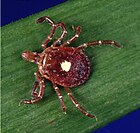Taxonomy
Ixodidae
EOL Text
Ticks are gruesome parasites that suck blood. They don't distinguish much between hosts: dogs, cats, people and other mammals. Ticks carry the infamous Lyme disease. They can let themselves fall out of trees and bushes but the greatest chance of contact is walking through high grass and wild flowers. The most important months to watch out for ticks are from April through October. Strange enough, they seem to be less present in nature areas where cattle roam. A tick usually visits three different hosts during its lifetime. Between two meals, they can go for months without food. Ticks are not only found in woods, but also in the dunes.
| License | http://creativecommons.org/licenses/by-nc/3.0/ |
| Rights holder/Author | Ecomare |
| Source | http://www.ecomare.nl/index.php?id=3737&L=2 |
Teken zijn griezelige diertjes die bloed zuigen. De gastheer maakt niet uit: honden, katten, mensen en andere zoogdieren. Ze dragen de beruchte ziekte van Lyme en andere ziekten over. Ze laten zich uit bomen en struiken op hun prooi vallen, maar teken zitten voornamelijk in (hoog) gras en op kruiden. Je moet er voor oppassen vanaf april tot in oktober. In natuurgebieden waar runderen grazen blijken minder teken voor te komen. Een teek bezoekt in zijn leven meestal drie verschillende gastheren. Tussen twee maaltijden in kunnen ze maandenlang zonder voedsel. Teken komen niet alleen vaak in bossen, maar ook in de duinen voor.
| License | http://creativecommons.org/licenses/by-nc/3.0/ |
| Rights holder/Author | Ecomare |
| Source | http://www.ecomare.nl/index.php?id=3737&L=2 |
There are many genera and species of ticks in the families Ixodidae (hard ticks) that are of public health importance. Some representative genera, and diseases they are known vectors for, include: Amblyomma (tularemia, ehrlichiosis, Rocky Mountain spotted fever [RMSF], boutonneuse fever); Dermacentor (RMSF, Colorado tick fever, tularemia, Siberian tick typhus, and Central European tick-borne encephalitis, as well as being an agent of tick paralysis); Hyalomma (Siberian tick typhus, Crimean-Congo hemorrhagic fever); Ixodes (Lyme disease, babesiosis , human granulocytic ehrlichiosis, Russian spring-summer encephalitis); and Rhipicephalus (RMSF and boutonneuse fever).
Members of the family Ixodidae undergo either one-host, two-host or three-host life cycles. During the one-host life cycle, ticks remain on the same host for the larval, nymphal and adult stages, only leaving the host prior to laying eggs. During the two-host life cycle, the tick molts from larva to nymph on the first host, but will leave the host between the nymphal and adult stages. The second host may be the same individual as the first host, the same species, or even a second species. Most ticks of public health importance undergo the three-host life cycle, whereby the tick leaves the host after the larval and nymphal stages. The three hosts are not always the same species, but may be the same species, or even the same individual, depending on host availability for the tick.
(Centers for Disease Control Parasites and Health website)
| License | http://creativecommons.org/licenses/by-nc-sa/3.0/ |
| Rights holder/Author | Shapiro, Leo, Shapiro, Leo, EOL Rapid Response Team |
| Source | http://eolspecies.lifedesks.org/pages/74833 |
Barcode of Life Data Systems (BOLD) Stats
Specimen Records:3013
Specimens with Sequences:2321
Specimens with Barcodes:2129
Species:210
Species With Barcodes:158
Public Records:960
Public Species:104
Public BINs:121
Collection Sites: world map showing specimen collection locations for Ixodidae![]()
The Ixodidae are a family of ticks containing the hard ticks.
§Description[edit]
They are distinguished from the other main family of ticks, the soft ticks (Argasidae) by the presence of a scutum or hard shield.[1] In both the nymph and the adult, a prominent capitulum (head) projects forwards from the animal's body; in the Argasidae, conversely, the capitulum is concealed beneath the body.
§Classification[edit]
Of the 702 species in 14 genera,[2] some are of considerable economic importance as vectors of diseases caused by bacteria such as Rickettsia and Borrelia.[1]
The family contains these genera:[2]
- Amblyomma – 130 species (includes some of Aponomma)
- Anomalohimalaya – three species
- Bothriocroton – seven species
- Cosmiomma – one species
- Cornupalpatum – one species
- Compluriscutula – one species
- Dermacentor – 34 species (includes Anocentor)
- Haemaphysalis – 166 species
- Hyalomma – 27 species
- Ixodes – 246 species
- Margaropus – three species
- Nosomma – two species
- Rhipicentor – two species
- Rhipicephalus – 82 species (includes Boophilus)
§See also[edit]
§References[edit]
- ^ a b D. H. Molyneux (1993). "Vectors". In Francis E. G. Cox. Modern parasitology: a textbook of parasitology (2nd ed.). Wiley-Blackwell. pp. 53–74. ISBN 978-0-632-02585-5.
- ^ a b Alberto A. Guglielmone, Richard G. Robbing, Dmitry A. Apanaskevich, Trevor N. Petney, Agustín Estrada-Peña, Ivan G. Horak, Renfu Shao & Stephen C. Barker (2010). "The Argasidae, Ixodidae and Nuttalliellidae (Acari: Ixodida) of the world: a list of valid species names" (PDF). Zootaxa 2528: 1–28.
§External links[edit]
|
|||||||||||||||||||||||||||||||||||||||||||||||||||||||||||||
| License | http://creativecommons.org/licenses/by-sa/3.0/ |
| Rights holder/Author | Wikipedia |
| Source | http://en.wikipedia.org/w/index.php?title=Ixodidae&oldid=650737054 |

